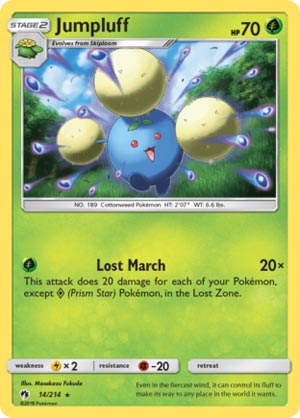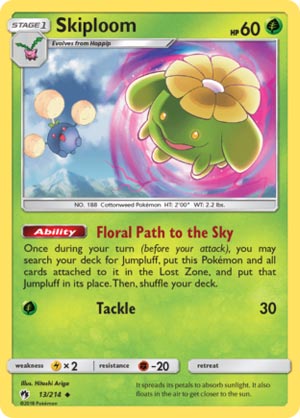 |
 |
Jumpluff & Skiploom – Lost Thunder
Date Reviewed: November 22, 2018
Ratings: Standard: 3.67 Expanded: 3.72 Limited: 2.92
Ratings are based on a 1 to 5 scale. 1 is horrible. 3 is average. 5 is great.
Reviews Below:
 aroramage And now’s about the time we get into the main course of the Lost March archetype, and it would be the salad. Yeah, we put the bird before the salad. How’s that for a Thanksgiving tie-in? Merry Bird-Day to you all, FOOLS!! …unless you’re vegetarian, I guess. Skiploom is the first part of this two-parter, being the Stage 1 Grass Pokemon, 60 HP, with a Lightning Weakness, a Fighting Resistance, and a Retreat Cost of 0. Off the top there, the Weakness/Resistance is completely wonky, until you remember that this line-up is considered Grass/Flying in the games, and Flying Pokemon will generally translate with that Lightning Weakness/Fighting Resistance most of the time. Tackle is the only move that Skiploom has, a 1-for-30 vanilla strike that will never be used because you’ll always use the Ability instead. Floral Path to the Sky, aside from being a fairly long name, is the Ability in question, which lets your search your deck for Jumpluff, and then put Skiploom and all cards attached to it into the Lost Zone to put that Jumpluff into play. Sort of a lost evolution of sorts. Jumpluff is the Stage 2 Grass Pokemon, 70 HP, with a Lightning Weakness, a Fighting Resistance, and a Retreat Cost of 0. Lost March is all you need to know, and it only costs 1 Grass Energy while dealing damage based on the Pokemon in the Lost Zone. Combined with Skiploom’s lost evolution, the attack ought to be doing at least 40 damage right off the bat (since Skiploom puts both itself and the Hoppip you evolved it from into the Lost Zone by its Ability), and if you’ve been playing the deck well enough, you should also have used at least 1 Trumbeak and 1 Lost Blender to boost that damage up by another 60. By using multiple Skiplooms, Trumbeaks, and Lost Blenders, you can add upwards of an extra 100 damage with each one, maxing out at a possible 400 damage in total, assuming 4 of each combination is used (4 Skiplooms, evolved from 4 Hoppips, with 4 Trumbeaks, and 4 Lost Blenders putting a total of 8 cards into the Lost Zone = 20 cards total). Of course, you won’t need to max out on all of these to get to the ideal total of around 260 that can OHKO anything in the game right now, and since nothing resists Grass Pokemon, Jumpluff does make for a great attacker, especially since it’s not as fragile as Natu and has a much easier time being evolved into than say Lampent of Night March. Jumpluff completes the Lost March archetype by giving it a fairly decent attacker that doesn’t require a lot of Energy and whose evolution line-up comes with a built-in mechanic for powering up its main attack. Natu can be used as an effective secondary attacker combined with DCE and which can be used to come out faster for double the Energy cost and half the HP. Meanwhile, maximizing on Trumbeak and using its Ability whenever you draw it quickly fills up the Lost Zone while Lost Blender puts extra Pokemon you don’t need and Skiploom brings out Jumpluff faster. With all of this in mind, you can get a fairly solid deck build going. I can’t think of a lot of weaknesses to the Lost March deck. It doesn’t share the weaknesses that Night March has, such as the usage of a Karen to shuffle back all the Pokemon in the discard pile away, as there’s nothing that currently interacts with the Lost Zone in that manner, meaning that for the most part it’s a generally more powerful variant of Night March. It can’t fuel up as quickly with Battle Compressor, but it does share a few tools in its own resources enough to generate a massive amount of Pokemon in the Lost Zone for the main attack. One weakness that could be highlighted is the slowness of Jumpluff, as in order to bring it out with the biggest benefits for the deck as a whole, you have to play the fairly vulnerable Hoppip to evolve into Skiploom, which with a whole turn of it staying in play could be risky, as it might get KO’d by an opposing Pokemon or dragged out by Custom Catcher or Guzma before the evolution takes place. Of course, if that happens, you can always use Lost Blender on your extra Skiploom and Jumpluff to draw a card and continue onward, but it’s better to build the deck around that possibility coming up with a back-up plan of sorts. Lost March definitely looks like it could become the next Night March deck, and it might become a fairly dominant force in the game once the ratios are all worked out. There is the built-in Lightning Weakness, a Type which has recently gotten a lot of support for itself with this set, so we have an immediate counter to the deck if that ends up becoming dominant, though it’ll likely need to go through some growing pains to become perfected. Whether or not it’ll actually become the next Night March remains to be seen, but I wouldn’t hold my breath if it does. Rating Standard: 4/5 (there are some inherent weaknesses in this deck) Expanded: 4.5/5 (but inherent weaknesses don’t always translate to a bad deck) Limited: 3.5/5 (most of the time, it actually ends up doing rather well despite that – just look at Night March!) Arora Notealus: Another cheap attack that can do massive damage and has a strong set of cards to associate with it that can help it perform well in competitive play for months to come? Certainly sounds like Night March – except that they came out with three users, only one of which actually saw the attacking role, and a card that could fuel the discard pile by three cards each use. Course, you don’t have to put Lost March users to unlock Lost March’s power, and that’s where I’d imagine you’ll see a few deck builds expand beyond that as the main theme; could be the case that there are strong mixes for the Lost March deck that Night March couldn’t normally have! Next Time: But you’re probably wondering about some other cards from this set that are looking to impact the game in their own way… |
 Vince Our next appendix for the best card of the set is Skiploom and Jumpluff! This is one of the few evolutionary lines that gave a lot of contribution, unlike the other 95% that were mostly filler…only for the highest stage to derserve attention (I.e bad basic & Stage 1, but good Stage 2). Hoppip is still filler, but Skiploom has an ability that greatly helps Lost March. Floral Path to the Sky (or the shadow realm) lets you search your deck for Jumpluff, puts Skiploom and all cards attached to it into the Lost Zone, and makes Jumpluff takes its place. Which means both Skiploom and Hoppip goes to the Lost Zone. This would be a good target for Professor Elm’s Lecture because both Skiploom and Hoppip has 60 or less HP. Jumpluff, is another Lost March attacker, but will probably be used more than Natu because it’s attack requires a single Grass energy. Due to both Hoppip and Skiploom being in the Lost Zone, that’s 40 more damage you can deal, which is a good start for Jumpluff, before you factor in other Pokemon in the Lost Zone. Being a Grass Type means it can exploit weakness found on Water and Fighting types, making the job much easier as it doesn’t need as much Pokémon in the Lost Zone than if you’re dealing neutral damage. Free retreat is also wonderful, as it can let you get a damaged Jumpluff away and bring in another one. That’s where all the positives stop. Because Hoppip and Skiploom leaves play and Jumpluff takes its place, it counts as Unevolved Pokemon despite saying its a Stage 2 Pokemon (because there’s no Pokémon under Jumpluff). Very few cards references Unevolved Pokemon such as Machamp from previous Throwback Thursdays. 70 HP on a Stage 2 is like Base Set days. While you’re capable of OHKO any Pokemon in the game with Lost March, you’re more likely to get taken down on the following turn. You can easily win the prize trade against two or three prize Pokémon, but for single prize Pokémon? It’s a matter of time until you manage to pressure your opponent’s setup so that they can’t pressure you. Rambling aside, this is definitely a must run in Lost March decks. One thing that Lost March has that Night March doesn’t is that your opponent cannot mess with your Lost Zone (unlike when Karen gets all of both player’s Pokémon from the discard pile onto their decks), meaning you can maintain damage output. I guess Night March is ready for retirement and let Lost March take over.
|
|
Skiploom & Jumpluff (LOT 13 & 14) float into the Pokemon Trading Card Game from the Lost Thunder expansion set. Their first incarnations in the Sun and Moon era might become the most potent archetype of this period. If you’ve played with this deck, you’ll understand why it’s the feature card of all of this week’s reviews. And there’s no question that this archetype has been completely constructed. Sometimes decks just come together organically. The Zoroark controls deck is a great example of a deck that the designers clearly had no idea would congeal the way it has. Other archetypes are very artificial, meaning that the designers specifically designed cards to benefit a particular archetype (Lucario UPR 67 being the textbook example of this). All of the cards we’re reviewing this week – from Lost Blender to Trumbeak to Skiploom – all were specifically designed to increase the potency of this deck. And they built it EXTREMELY well. It took me a few games to figure it out – I went 4 W 3 L in my first seven matches, but it’s been sunshine and lollipops since then going 48 W 24 L in 72 matches (67%). The more I play with it, the more I realize that Jumpluff is the feature attacker in the archetype. Most builds that I’ve seen only run the barebones 4-4-4 Jumpluff line, 4 Trumbeak, and 4 Natu, with maybe Tapu Lele GX or Oranguru or even Zebstrika for draw support. I include Dunsparce (CES 110) and Alolan Vulpix (GRI 21). I initially included Fairy Alolan Ninetales GX (LOT 132), but in an early version, I found that I didn’t play it a single time in eight games, so I decided to cut it. Running all of those extra Pokemon, however, really helps get the damage count up though. I usually have an extra Pokemon or two in hand when I get my Lost Blenders, and obviously if you don’t start Dunsparce or Vulpix, you’re probably not going to bench them at any point later in the game, so they make for perfect Blender fodder. You can also Blend a couple of the Jumpluff line or a Natu as well, you just have to make sure of your counts early in the game. If I see that I have a Jumpluff or Skiploom prized, I know that I can blend one or both of those cards early on because there’s a chance I might get one out of the prizes later on. You’re probably only going to be able to get two or three Hoppip / Skiploom combinations into the Lost Zone anyways; I rarely get all four. I average putting two Jumpluff in play per game, and I actually only average one and a half Natu, so blending away a couple of those early isn’t the end of the world, you just need to be conscious of what you’ve “Thanos’d” away. But you could literally Blend or discard two Natu AND two Hoppip and still have four potential attackers, and four’s a good enough number for you in most games. So if you haven’t tried the Lost March archetype yet, I’d highly recommend it. It’s fun and it’ll win you some matches. Tapu Koko (SM31), Shuckle GX, and Giratina have had the most success against me, and in recent matches I have been playing a couple of Sky Pillars and Machoke (GRI 64) with Ditto. And I’m sure this archetype is literally one good card away from being as dominant as Night March was – it’s pretty close as it is. I am frequently able to attack for mid 100’s damage on my turn 2 or 3, and with all of those extra Pokemon, I can even ramp up to the high 200’s late in the game. Pretty good numbers for a 70 HP Pokemon. Rating Standard: 4 out of 5 Conclusion As I mentioned, it’s still about a card away, and it definitely has counters that can really frustrate you, but it will win a lot of matches for you, just realize it might take you a few games to figure it out. If you’d like to see some decklists, I have a number of different videos on Lost March, here’s a link to a good representation of one. |
 Otaku We have had something of a bizarre adventure with our Top 10 Countdown this time. Here is a link for how it normally is supposed to work. Even if this if your first Card of the Day review you’ve ever read, you already know something is off because the title of this page says it is part of a Top 11 countdown, not a Top 10. There being two cards labeled #1d and #1e are also a big clue. This countdown, we had a group of related cards nominated for a single slot, which is something we allow if it won’t make things too complicated. It is my job to make sure it doesn’t get too complicated and… well… I blew it. My solution was changing it to a Top 11 so we could cover the cards nominated, hence covering three other #1’s over the last three days. Today’s duo, however, do make perfect sense to review together: say hello to our final number ones, Skiploom (SM – Lost Thunder 13/214) and Jupmpluf (SM – Lost Thunder 14/214). We’ll begin with Skiploom. It is a [G] Type evolving Stage 1 Pokémon with 60 HP, [L] Weakness, [F] Resistance, free Retreat Cost, the Ability “Floral Path to the Sky”, and the attack “Tackle” for [G], doing 30 damage. The effect of Floral Path to the Sky may be activated only on your own turn, once-per-copy and before you attack or do something else that automatically ends your turn after it resolves. It searches your deck for a Jumpluff; IF you find one, you send Skiploom and all cards attached to it to the Lost Zone then Bench that Jumpluff directly to the field from your deck. If you’re me, you know this from how past cards work and a few rulings, because the English text is (at best) ambiguous in some places, if not downright misleading. You’d think this would eliminate the value of the other traits, but most are still relevant. Being a [G] Type can matter for support cards like Revitalizer. Being a Stage 1 is still okay, as it isn’t too slow. 60 HP, normally awful for a Stage 1, becomes a boon as it allows Professor Elm’s Lecture to fetch Skiploom from your deck. The HP already makes the Weakness and Resistance largely irrelevant. The free Retreat Cost is perfect but you won’t hopefully need it all that often. 30 damage for [G] is mediocre, but if you’re desperate… at which point hitting [G] Weakness may also matter (but usually not). Jumpluff is a Stage 2 [G] Type Pokémon with 70 HP, [L] Weakness, [F] Resistance, free Retreat Cost, and the attack “Lost March” for [G], which does 20 damage per Pokémon you have in the Lost Zone excluding Prism Star Pokémon. Being a Stage 2 card makes Jumpluff slow BUT only if you’re unable to use Skiploom’s Ability; only use Rare Candy if you’re incredibly worried about Ability-lock. The [G] Typing is still okay; you might be in play long enough to take advantage of another piece of support or two… and hitting [G] Weak Pokémon for double damage is good (though far from the best) right now. Lost March is a very good attack. If we had more easy methods of sending Pokémon to the Lost Zone, it would be great! As Prism Star Pokémon don’t count towards its damage, unless you luck into an opponent using effects to remove your Pokémon for you, you’re limited to
Trumbeak is the only one here that reliably removes a Pokémon – itself – with the only things that can prevent this being Ability-lock that affects the hand or if your opponent has no cards left in their deck (see its Ability if you don’t understand why). Spinarak is technically the next most reliable; its first attack costs [G], Paralyzes and Poisons the opponent’s Active, then sends the attacking Spinarak and all attached cards to your Lost Zone. However, in this case, being reliable is not worth it eating up one of your attacks. Lost Blender is a Trainer-Item which requires you have two cards in hand to send to the Lost Zone to draw a card; Item-lock isn’t currently an issue in competitive Standard play, but not having two Pokémon in hand you can afford to send to the Lost Zone is a legitimate risk. Skiploom requires Evolving a Hoppip that’s been in play for a turn already, and I already mentioned you need a Jumpluff in your deck. Of course, Ability-lock stops it as well. Skiploom is actually so valuable to the Lost March attack that, even if you wanted to focus on Natu (SM – Lost March 87/214) you still need to use Skiploom and thus need to also run Jumpluff. Skiploom is the best Skiploom we’ve ever gotten in this game. There is one other that had a really great non-attack effect, Skiploom (EX- Team Rocket Returns 49/109). It’s “Buffer” Poké-Body would trigger ANY time Skiploom would be KO’d by an opponent’s Pokémon’s attack; you got to flip a coin and if “heads” Skiploom wasn’t KO’d but still had 10 HP remaining! Poké-Bodies are a precursor to Abilities and work in a similar manner. Buffer could be very, very frustrating. Getting back to Floral Path to the Sky, it does present one drawback for any Jumpluff using it; a KO’d Jumpluff needs a different way to hit the field. If all your Hoppip and Skiploom are removed, you’ve got no way of doing it save for some really convoluted tricks. There only great Hoppip is not legal for the Expanded or Standard Formats; Hoppip (EX – Team Rocket Returns 57/109) ALSO has Buffer! For that matter, so did Jumpluff (EX- Team Rocket Returns 11/109)… but for Standard and Expanded legal Hoppip, choose between Hoppip (SM – Lost Thunder 11/214) and Hoppip (Lost Thunder 12/214). Both are [G] Type Basic Pokémon with [L] Weakness, [F] Resistance, Retreat Cost [C], and a single attack. Hoppip (SM – Lost Thunder 11/214) has 30 HP and the attack “Multiply”, which costs [C] and lets you search your deck for a Hoppip, then Bench that Hoppip. Hoppip (Lost Thunder 12/214) has 40 HP and the attack “Tackle” for [G], doing 20 damage. There is enough spread in the game I am not sure which one is truly better in the current metagame. Alright, so with all of that addressed, what is this card’s prospects in Standard and Expanded? Well, Skiploom seems essential to all Lost March decks due to its Ability that requires a Jumpluff, and why wouldn’t you run the Lost March Jumpluff in a Lost March deck? I don’t have enough data, so I’m going to trust what 21times says since it more or less aligns with the one or two times I faced a Lost March deck; Jumpluff really is the main attacker even though it needs more setup than Natu. If we get more cards to remove our own Pokémon in an effective manner, that could change. What both Jumpluff and Skiploom hope change is the performance of Lost March decks. Maybe folks haven’t quite worked out how to best build or run them, but they aren’t exactly taking the metagame over by storm. I’m a bit surprised I haven’t faced more in the PTCGO. So, together, Jumpluff and Skiploom seem like solid but not amazing cards. Then again, that was how Night March started before its natural counter – Lysandre’s Trump Card – was banned. I really would like to test these two in Expanded; it would probably be overkill, but as Skiploom bails with all cards attached to it, Ditto (BW – Boundaries Crossed 108/149) and/or Klefki (XY – Steam Siege 80/114) could go along with it. If you’ve got the Hoppip, this should be… well, not great if it is only a 1-1-1 line. Get at least a 1-1-1 line and a Lost Remover, and you’ve got the start of something. Ratings (Composite) Standard: 3.15/5 Expanded: 3.15/5 Limited: 3.25/5 Lost March hasn’t lived up to the hype, but there’s just enough potential here, even without future support, that we shouldn’t write it off yet. Some of 21times’ optimism has infected me, but not that much of it. At the very least, the deck seems… fun. |
We would love more volunteers to help us with our Card of the Day reviews. If you want to share your ideas on cards with other fans, feel free to drop us an email. We’d be happy to link back to your blog / YouTube Channel / etc. 😉
Click here to read our Pokémon Card of the Day Archive. We have reviewed more than 3500 Pokemon cards over the last 17+ years!




